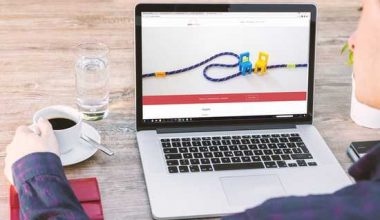A landing page is an independent web page that visitors can “land” on after clicking through from an email, advertisement, or other digital source. In exchange for something valuable, such as a retail discount code or business-to-business (B2B) insights in the form of a white paper, a landing page seeks to collect contact information from visitors. In contrast to other web pages, landing pages don’t belong in a website’s evergreen navigation. To learn more about the free landing page, here is how to create and find a builder.
Free Landing Page
An individual “lands” on a landing page when they click through from an email, advertisement, or other digital location. Landing pages should be included in every content strategy to enhance conversions and drive more traffic.
Once a visitor lands on your landing page, you want them to take some sort of action, like sign up for your list or buy something. Your landing page has been successful in converting users if they do the precisely targeted action. Typically, landing pages only persuade visitors to perform one of these actions, such as completing the page’s unique signup form. Why? Researchers refer to this as the “paradox of choice.” That basically indicates that the more options you provide individuals, the more difficult it is for them to decide and take action.
Types of Landing Pages
In terms of design, landing pages often have one of two purposes: either they generate leads or they point visitors to the next action.
#1. Lead Generation Landing Pages
This kind of landing page, sometimes referred to as “lead gen” and “lead capture” pages, focuses on gathering lead information. In other words, it gathers data about your clients.
A form that acts as the CTA is a lead capture page’s distinguishing characteristic. It requests user information such as names, email addresses, and phone numbers in exchange for a good or service. Even more particular information, such as their ages or jobs, might be requested. In this manner, you can get in touch with leads and foster their interest in your company.
#2. Click-through Landing Pages
CTA buttons are the main focus of click-through landing sites, as opposed to lead generation pages, which feature forms. Your users are directed to a page where they can carry out the desired action by clicking the button. For instance, clicking a button that says “schedule a demo” may link the user to a scheduling page, clicking a button that says “order X now” may direct the user to a checkout page, and so on.
Importance and Benefits of a Landing Page
Landing pages are distinct from other pages on your website since they concentrate on particular, immediate objectives that will help you achieve your desired results. In addition to raising conversion rates, enhancing paid advertising efforts, and producing fresh audience data, landing pages can:
- Increasing your credibility: Users often respect messaging that is straightforward and emphasizes the benefits of what you’re delivering. A carefully thought-out landing page demonstrates to your clients that you have their best interests at heart.
- Strengthen your brand: Utilize what you’ve learned since you’ve already worked hard to develop a digital brand. This is the outcome of keeping consistency in the look, feel, style, and copy of your website.
- Creating leads: Both kinds of landing pages can enhance revenue for your company and produce leads. Since landing pages are more specifically targeted, they can put more emphasis on conversion rates than on knowledge and content.
- Boosting traffic: With a landing page, you may improve website traffic even if generating leads isn’t your primary objective. This will raise brand awareness and let potential customers learn more about your company.
How to Create a Free Landing Page
To create a free landing page, follow these steps:
#1. Target long-tail keywords
These are very specific keywords or phrases that typically have four words or more. Long-tail keywords typically have lower levels of competition than short-tail keywords, making it considerably simpler to rank for long-tail keywords. Additionally, since landing pages have very targeted CTAs, it is simple to seamlessly incorporate long-tail keywords into their content.
#2. Segment your Traffic
Your target audience probably comprises multiple personas. For instance, if you sell reusable water bottles, you should market them to a variety of consumers, such as hikers, vacationers, and sports. You’ll need a variety of strategies to appeal to these diverse customer personas because of their differences.
#3. Improve Page Loading Speed
When so many other businesses are vying for a potential customer’s attention, it can be challenging to keep it. Users are easily distracted and impatient, therefore if your landing page loads slowly, your chances of getting them to convert decrease.
#4. Acquire Backlinks
These are backlinks that lead to your website from other websites. They effectively serve as votes of confidence in the eyes of search engines by sending traffic to your landing pages. Backlinks demonstrate the value of the content on your page when they originate from reputable, high-authority websites. As a result, your website will rank higher on search engine results pages.
That entails giving it a distinctive or innovative element. Keep in mind that each of your potential leads has connections to other people who might be interested in what you have to offer. You can access these bigger networks if you let people share your landing pages.
#6. Create a Captivating Headline.
Draw users in with an attention-grabbing headline. You can get people’s attention by using certain terms like “free” or “now.” To keep visitors on the page long enough to convert, pair your intriguing title with effective copywriting.
#7. Make an Effort to Place Your Ctas Above the Fold
One of the first website items that visitors will see is your CTA. Unfortunately, especially when designing for mobile consumers, this isn’t always feasible.
#8. To Direct Users to Your CTA, Employ Directional Signals.
Arrows or a picture of a person looking in the direction of your CTA are good examples. This is particularly crucial if your CTA is below the fold. Well-placed indications urge visitors to scroll, read on, and make a purchase.
#9. Display Your Item or Service in Action
If your product is unusual or not well known, a video or product demo might give context. This information also makes it easier for prospective buyers to imagine utilizing your good or service.
Do you have endorsements from satisfied clients? If so, mention them in the copy on your landing page. You can also keep track of how many individuals have already taken advantage of your offer if your good or service is well-liked. By demonstrating social proof, you can persuade people to join the bandwagon and test your good or service for themselves.
#11. Use Subheadings
Use numbered lists or bullet points to list the features and benefits of what you are giving since there is probably more than one of each. Because it is easy on the eyes and easier to scan than a massive block of text, this is more reader-friendly.
#12. Say Your CTA Again
Placing your CTA near the top, finish, or even in the center of a page that has a lot of material might be helpful. Your readers’ odds of taking action increase as you offer more conversion options, but be careful not to overwhelm them. Here are a few additional ideas for designing landing pages.
#13. Indicate How to be Reached.
Even the leads who won’t actually contact you will feel more comfortable knowing they have the choice to do so. Why? Giving consumers your contact information is a sign of credibility because it lets them know you’re available to assist them if they need it.
#14. Use Video to Convey Your Message
Because not everyone will read the copy on your landing page, video content is becoming more and more popular. However, this does not imply that there should be no text on your website. Text and video information can work well together to draw in and hold people’s attention.
#15. Try Out Different Iterations of Your Pages.
Different headlines, images, calls to action, and other elements can result in various outcomes. To find the most effective variations of your landing pages, do A/B tests on each one. This might assist you in optimizing your landing pages for maximum effectiveness.
Free Landing Page Builder
Fortunately, a number of free tools allow you to create straightforward but efficient landing pages. To make the most of these sites, you may include components like Calls to Action (CTAs) and contact forms. Free landing page builders are frequently simple to use and appropriate for novices.
#1. Wix
Wix is a top free landing page builder. It offers a large variety of templates for various landing page layouts. After selecting a template, you can easily update it with the Wix editor. Your menu, page layout, design components, and more are all under your control. Since Wix is a full-featured website builder, you can also create a homepage, a blog, eCommerce shop pages, and more. The service also offers a totally free option.
#2. SITE123
Consider using SITE123 if you’re seeking a free landing page builder that will enable you to create a page in a matter of minutes. With a straightforward user interface and a focus on single-page and multipage sites, this platform may assist you in the design process.
You’ll be prompted to select your business type and give your website a name after creating your account. After that, you’ll be led straight to the SITE123 editor. The left-hand option there allows you to choose templates. The themes from SITE123 are made to be responsive on mobile devices. Given that more than 50% of web traffic is increasingly coming from mobile devices, this capability is crucial.
#3. Carrd
Carrd is yet another free landing page builder for the task if you’re trying to create a straightforward yet personalized one-page site. For the launch of products and websites, it has a selection of landing page templates. It also provides buttons for social media. 13 of these templates are furthermore accessible through Carrd’s free plan. It’s simple to customize a free design once you’ve selected one. New elements can be dropped onto the page and their styling changed.
On this list, Carrd is a landing page builder that is most user-friendly for beginners. That simplicity, though, has some disadvantages. With Wix or even Jimdo, it could be difficult to modify your page as much as you would like. Still, Carrd can accomplish the job if you have simple marketing objectives and little time to devote to web design.
#4. Jimdo
Small business owners and freelancers should choose Jimdo. It is intended for independent contractors who need to quickly create a full website or landing page. Jimdo will ask you if you’re new to website development when you register an account. Additionally, you’ll be asked to say if your website is for personal use, a brand-new endeavor, or an existing company. After that, you may choose your style from a selection of color schemes and your industry. This data will be used by Jimdo to offer customized templates for your requirements.
Due to its generous storage and bandwidth allotments, Jimdo is among the finest free landing page builders. It supports up to five pages and provides a lot more resources than Wix and SITE123. Additionally, it makes advantage of HTTPS to safeguard your website and convince users of your trustworthiness.
#5. ConvertKit
ConvertKit provides company resources like free landing page templates, email sign-up forms, and email marketing software. Professionals in the creative industries, such as podcasters, singers, writers, and personal coaches, are catered to by the site.
ConvertKit will ask you for information about your audience size, type of creator, and marketing objectives when you sign up for the service. Following that, you may select from a variety of themes geared toward the creative sectors and navigate to make a landing page. The text, formatting, colors, and images on a ConvertKit landing page template are fairly editable.
WordPress Free Landing Page
The free landing page on your WordPress website should reassure clients who are visiting. So that you can convert these potential customers into actual clients, they should be able to easily learn about the good or service you offer. A landing page website’s responsibility is to give visitors all the information they need on the first page they arrive at. The goal is to give users clear information that will aid in their comprehension of your business. This aids in drawing potential clients to the goods or services you provide.
If you can locate the ideal WordPress theme, you can receive all the characteristics required for a beautiful free landing page for no dime, and they are as follows:
#1. Blossom Coach
The finest WordPress landing page for coaches, mentors, presenters, and therapists is Blossom Coach, a free theme. This theme works particularly well for landing page websites and is wonderful for generating leads. Similarly to that, the social media integration function enables you to connect your social media accounts to your website, increasing exposure and gaining more followers.
#2. Coachify
Presenting Coachify, the pinnacle of WordPress free landing page themes, painstakingly designed for those looking to enthrall their audience with style and panache. This ground-breaking theme effectively generates leads while showcasing your content, engaging site visitors, and providing pertinent information about your company.
Additionally, Coachify’s clever call-to-action buttons are your hidden weapon since they entice your audience to take action, whether it’s scheduling a session, signing up for a newsletter, or contacting you. This theme ensures that your company succeeds in the cutthroat internet market by understanding the need for efficient lead creation.
#3. Vandana Lite
Vandana Lite is a fantastic theme for free landing pages that will best display your selling points. This theme is ideal for therapists, life coaches, and even companies. This theme stands out from other free WordPress themes with its attractive style. With this theme, you can present your services and qualifications in a visually appealing manner while also having some efficient lead-generation tools at your disposal.
Utilizing social media integration, which includes an Instagram feed, you may also increase your online following. For creating an online store or accepting payments for services, Vandana Lite now supports WooCommerce.
#4. Blossom Spa
The Blossom Spa theme was created for a certain type of company. This theme is a fantastic fit for companies in the health and wellness industries thanks to its focused design and appropriate selection of typography and sections. This free theme’s unique design and outstanding content design enable you to display your services, engage your visitors, build your credibility, and even turn them into customers.
Additionally, Blossom Spa has header CTA buttons and a CTA section. The wonderful Testimonials area can be used to increase your trustworthiness. It’s also helpful to include a full-width Instagram area on your social media pages to add diversity and draw users in.
#5. CoachPress Lite
For coaches, therapists, mentors, speakers, therapists, and business owners, CoachPress Lite is a great choice for a WordPress free landing page. With a CTA area and a newsletter section, this simple yet elegant theme has a strategic design to increase lead-generating chances. Two blog page layouts, three banner options that may be customized, one header style, and one slider style are all included with CoachPress Lite. You have complete control over the typography to alter the look and feel of your website. You may choose from an endless number of colors and 900+ Google fonts.
How Do I Create a Free Landing Page to Collect Emails?
Follow these details thoroughly to create a free landing page:
- Put up a useful page.
- Create a concise CTA.
- Compose persuading copy.
- Don’t forget social proof.
- Ask for only what you require.
- Display the offer.
What Is the Difference Between a Landing Page and a Website?
A landing page is created with the only objective of converting visitors, as opposed to a website, which typically serves a variety of functions. A landing page presents a specific offer rather than distributing information or advertising the company generally.
Related Posts
- MARKETING COLLATERAL: 19+ Types of Marketing Collateral You Need
- LANDING PAGE OPTIMIZATION: Top Tools, SEO, Examples & Checklist
- Contingent Beneficiary: Definition, Characteristics & all you should know
- Top Email Marketing Platforms: 15+ Best Picks For 2023 (Updated!!)






